
Azhdarchidae is a family of pterosaurs known primarily from the Late Cretaceous Period, though an isolated vertebra apparently from an azhdarchid is known from the Early Cretaceous as well. Azhdarchids are mainly known for including some of the largest flying animals discovered, but smaller cat-size members have also been found. Originally considered a sub-family of Pteranodontidae, Nesov (1984) named the Azhdarchinae to include the pterosaurs Azhdarcho, Quetzalcoatlus, and Titanopteryx. They were among the last known surviving members of the pterosaurs, and were a rather successful group with a worldwide distribution. Previously it was thought that by the end of the Cretaceous, most pterosaur families except for the Azhdarchidae disappeared from the fossil record, but recent studies indicate a wealth of pterosaurian fauna, including pteranodontids, nyctosaurids, tapejarids and several indeterminate forms. In several analyses, some taxa such as Navajodactylus, Bakonydraco and Montanazhdarcho were moved from Azhdarchidae to other clades.

Tupuxuara is a genus of large, crested, and toothless pterodactyloid pterosaur from the Early Cretaceous period of what is now the Romualdo Formation of the Santana Group, Brazil, about 125 to 112 million years ago. Tupuxuara is a close relative of Thalassodromeus, and both form a group that is either called Thalassodrominae or Thalassodromidae.

Thalassodromeus is a genus of pterosaur that lived in what is now Brazil during the Early Cretaceous period, about a hundred million years ago. The original skull, discovered in 1983 in the Araripe Basin of northeastern Brazil, was collected in several pieces. In 2002, the skull was made the holotype specimen of Thalassodromeus sethi by palaeontologists Alexander Kellner and Diogenes de Almeida Campos. The generic name means "sea runner", and the specific name refers to the Egyptian god Seth due to its crest being supposedly reminiscent of Seth's crown. Other scholars have pointed out that the crest was instead similar to the crown of Amon. A jaw tip was assigned to T. sethi in 2005, became the basis of the new genus Banguela in 2015, and assigned back to Thalassodromeus as the species T. oberlii in 2018, though other researchers claim that Banguela is a valid genus. Another species was described in 2015 based on a supposed crest fragment, but this was later shown to be part of a turtle shell.
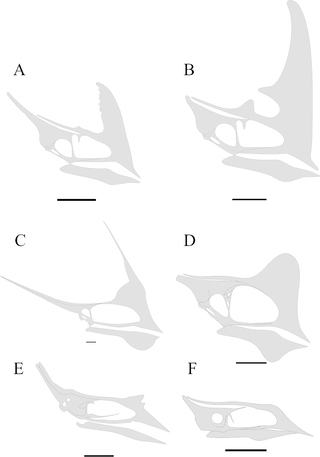
Tapejaridae are a family of pterodactyloid pterosaurs from the Cretaceous period. Members are currently known from Brazil, England, Hungary, Morocco, Spain, the United States, and China. The most primitive genera were found in China, indicating that the family has an Asian origin.

Bennettazhia is a genus of tapejaromorph pterosaur which lived during the Albian stage of the Early Cretaceous from what is now the Hudspeth Formation of the state of Oregon in the United States. Although originally identified as a species of the pteranodontoid pterosaur Pteranodon, Bennettazhia is now thought to have been a different animal. The type and only species is B. oregonensis.
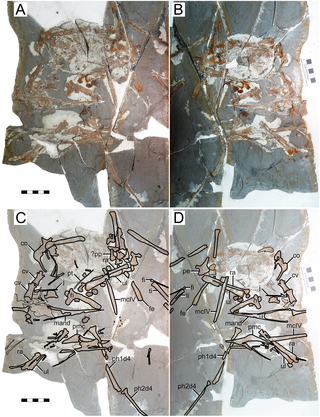
Eopteranodon is a genus of tapejarid pterosaur from the Aptian-age Lower Cretaceous Yixian Formation of Beipiao City, Liaoning, China. The genus was named in 2005 by paleontologists Lü Junchang and Zhang Xingliao. The type species is Eopteranodon lii.

Jidapterus is a genus of chaoyangopterid pterosaur from the Aptian-age Lower Cretaceous Jiufotang Formation of Chaoyang, Liaoning, China. The genus was in 2003 named by Dong Zhiming, Sun Yue-Wu and Wu Shao-Yuan. The type species is Jidapterus edentus. The genus name is derived from Jílín Dàxué or "Jilin University" and a Latinized Greek pteron, "wing". The specific name means "toothless" in Latin.

Lonchodectidae or Lonchodraconidae is a group of pterosaurs within the clade Pterodactyloidea. It has variously been considered to be within Ctenochasmatoidea, Azhdarchoidea and Pteranodontoidea. They are notable for their high, conical tooth sockets and raised alveolar margins.

Azhdarchoidea is a group of pterosaurs within the suborder Pterodactyloidea, more specifically within the group Ornithocheiroidea. Pterosaurs belonging to this group lived throughout the Early and Late Cretaceous periods, with one tentative member, Tendaguripterus, that lived in the Late Jurassic period. The largest azhdarchoids include members of the family Azhdarchidae, examples of these are Quetzalcoatlus, Hatzegopteryx, and Arambourgiania. The Azhdarchoidea has been recovered as either closely related to the Ctenochasmatoidea, as the sister taxon of the Pteranodontoidea within the Ornithocheiroidea, or within the Tapejaroidea, which in turn was also within the Ornithocheiroidea.

Tupandactylus is a genus of tapejarid pterodactyloid pterosaur from the Early Cretaceous Crato Formation of Brazil.

Chaoyangopteridae is a family of pterosaurs within the larger group Azhdarchoidea. Chaoyangopterids lived mostly during the Early Cretaceous period, though possible members, Microtuban, Xericeps and Argentinadraco, may extend the fossil range to the Late Cretaceous.
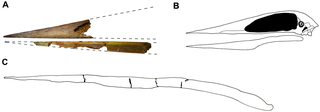
Alanqa is a genus of pterodactyloid pterosaur from the Late Cretaceous period of what is now the Kem Kem Beds of southeastern Morocco. The name Alanqa comes from the Arabic word العنقاءal-‘Anqā’, for a mythical bird of Arabian culture.

Dsungaripteridae is a group of pterosaurs within the suborder Pterodactyloidea. They were robust pterosaurs with good terrestrial abilities and flight honed for inland settings, and were commonly interpreted as durophagous and possibly piscivorous pterosaurs. Fossils have been discovered from Early Cretaceous deposits in Asia, South America and possibly Europe.

Aerotitan is a genus of large azhdarchid pterosaur known from the Late Cretaceous period of what is now the Allen Formation of the Neuquén Basin in northern Patagonia, Argentina.
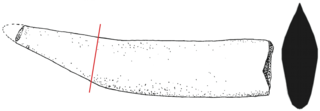
Banguela is a genus of azhdarchoid pterosaur from the Early Cretaceous period of what is now Brazil. Only one species is known, Banguela oberlii.

Tapejaroidea is a group of pterosaurs belonging to the clade Ornithocheiroidea. Tapejaroids lived from the Early to Late Cretaceous periods, with one possible member, Tendaguripterus, extending the fossil range to the Late Jurassic period. Tapejaroidea contains two groups, the Dsungaripteridae and the Azhdarchoidea, which in turn includes the azhdarchids, the group that contains some of the largest flying animals. The group was named by Brazilian paleontologist Alexander Wilhelm Armin Kellner in 1996.

Tapejaromorpha is a group of pterosaurs within the clade Azhdarchoidea. The fossil remains of tapejaromorphs dated back to the Cretaceous period.
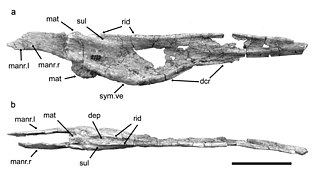
Argentinadraco is an extinct genus of azhdarchoid pterosaur from the Late Cretaceous Portezuelo Formation of Argentina. It contains a single species, A. barrealensis, named in 2017 by Alexander Kellner and Jorge Calvo. Argentinadraco is unusual for bearing a bottom jaw with a concave bottom edge, as well as a pair of ridges and depressions on the top surface. These features distinguish it from all other azhdarchoid groups, complicating its assignment, but it may belong to the Chaoyangopteridae. The ridges on the lower jaw may have been used to feed on small invertebrates in loose sediment within the system of lakes and rivers that it resided in.

Apatorhamphus is an extinct genus of azhdarchoid pterosaur from the Kem Kem Group of Morocco. It might have been part of the Chaoyangopteridae. It is only known from a few snout fragments and it likely had a wingspan of between 3–7 metres (9.8–23.0 ft)
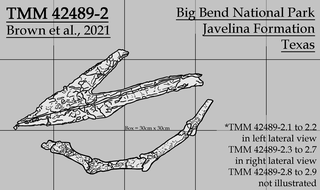
Wellnhopterus is an azhdarchid pterosaur recovered from the Late Cretaceous Javelina Formation in Texas that was previously identified as a thalassodromine. It consists of a set of upper and lower jaws, as well as some cervical vertebrae and a fragmentary long bone. In July 2021, the jaws were given the genus name "Javelinadactylus", with the type and only species as "J. sagebieli"; however, this article has now been retracted. In a paper published in December 2021, the complete holotype was independently named Wellnhopterus, with the only species being W. brevirostris. As of 2022, this is the formal name of this pterosaur.































